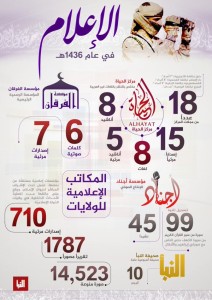On November 23, a supporter of the Islamic State posted a graphic on Twitter that purportedly summarizes the “caliphate’s” prolific propaganda efforts over the course of the previous year, from late 2014 to late 2015.
The graphic is watermarked with the logo for Al Naba newsletter, an annual report that the Islamic State and its predecessor organization have used in the past to document the group’s military and terrorist operations. The logo for Al Naba can be seen in both the lower left and right corners, with the latter indicating that 10 issues of Al Naba newsletter were published during the relevant timeframe.
Assuming that the information contained in the graphic is accurate, then it illustrates how the Islamic State’s so-called “provinces” now generate a considerable amount of media.
The Islamic State’s various wilayat, or “provinces,” produced 710 videos, 1787 photo reports, and 14,523 other images over the course of a year, according to the graphic. In all likelihood, the entities included in this category include those located in Iraq and Syria, the heart of the self-declared “caliphate,” as well as elsewhere. In November 2014, Abu Bakr al Baghdadi, who heads the Islamic State, announced the establishment of new entities in several countries. Additional international branches of the Islamic State have been created since then. Some of these “provinces” control real territory, while many do not.
The propaganda arms for each “province” work independently from one another, according to the graphic, but are supervised by the Islamic State’s main media house.
Al Furqan Media’s output, summarized in the upper left of the graphic, included six audio messages and seven videos. Al Hayat Center, shown in the upper right, produced content in eight different languages. This included 18 magazine editions and 15 videos, as well as 13 chants (5 in a video format and 8 others).
Al Ajnad, which focuses on audio recordings (its logo contains a microphone), recorded 99 recitations of chapters from the Koran and 45 chants.
The Islamic State also produces online magazines tailored to readers who are not fluent in Arabic. The magazines included, according to graphic, seven issues of the English-language Dabiq, six issues of Dar al Islam in French, three issues of the Turkish-language Constantinople, and two issues of Istok in Russian.
The Long War Journal has not independently confirmed the statistics listed, but the figures are generally consistent with the Islamic State’s output. The graphic was likely produced in order to reinforce the scale of the Islamic State’s media operations, reinforcing the perceptions of members and supporters that the “caliphate” is “remaining and expanding,” as the group’s propagandists often say.
Indeed, the messages and statements released by the various entities listed on the graphic are remarkably consistent in their branding. As opposed to al Qaeda, which uses multiple brands and often tries to hide its ties to jihadist groups, the Islamic State’s uniform branding is, in some ways, easier for new recruits and supporters to understand.









1 Comment
Visually, this graphic sucks as much as ISIS sucks on a philosophical level.